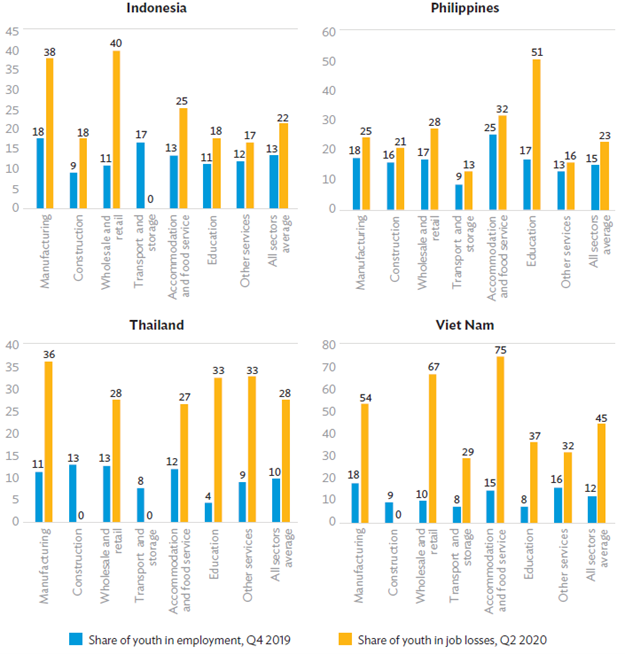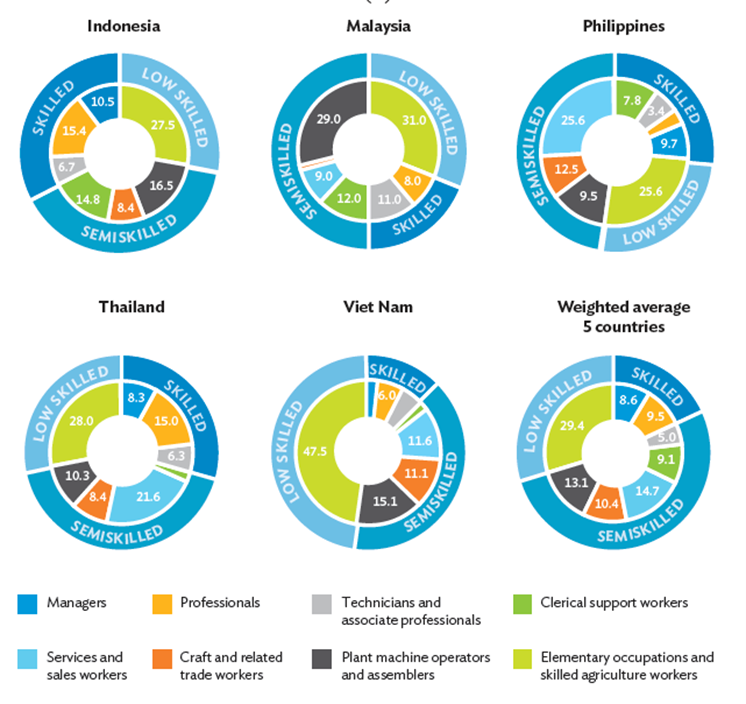Co-authors: Souleima El Achkar Hilal; Ian Nicole Generalao; and Rosa Mia Arao
This post draws from a paper presented in the ACAES session at the 2022 Allied Social Science Association Annual Meeting, program here. Youtube recording here.
The Covid-19 pandemic has had a devastating impact on labor markets worldwide, Southeast Asia included. There is clear evidence that the pandemic-induced job losses in the region have been highly unequal—disproportionately affecting the youth, women, low-skilled, informal, temporary, and casual workers.
Using the latest available Labor Force Surveys of Indonesia, the Philippines, Thailand, and Viet Nam, our analysis shows that youth and women bore the brunt of job losses. Young workers, who represent only 10–15% of the workforce in the four countries, accounted for a disproportionate share of job losses at 22–45% at the height of the pandemic’s impact on labor markets. This is due to their overrepresentation in heavily hit sectors like food and accommodation services, wholesale and retail trade, and “other services,” and because they were more likely to lose their jobs than more mature workers in these same sectors. Figure 1 gives details by sector.
|
Figure 1. Share of Youth in Sectoral Employment and in Net Job Losses (%)
Note: Shares in employment are for August 2019 for Indonesia and for Q4 2019 elsewhere. Shares in job losses are for Feb-Aug 2020 for Indonesia and for Q1-Q2 elsewhere. Source: Authors' calculations based on labor force surveys. |
Women were also disproportionately affected, recording a greater share in job losses than their share in employment. In Thailand, for instance, women accounted for approximately 60% of Q2 2020 job losses and around 90% of manufacturing job losses. Details by sector are shown in Figure 2. Moreover, women were more likely to exit the labor force following job loss than men. This is partly due to a larger share of the care burden falling on women. Although many female workers reentered the labor market in the second half of 2020, labor reallocation patterns pointed to an “added worker effect” or “distress employment.” This occurs when additional (female) family workers join the labor force to compensate for lost household income. The labor market reentry of women in the third quarter of 2020, mainly into lower “quality,” lower productivity jobs, implies that although there is no evidence of persistent labor market detachment, the pandemic could nevertheless have long-term negative impacts on the working lives of women.
|
Figure 2. Share of Females in Employment and in Net Job Losses (%) Note: Shares in employment are for August 2019 for Indonesia and for Q4 2019 elsewhere. Shares in job losses are for Feb-Aug 2020 for Indonesia and for Q1-Q2 elsewhere. Source: Authors' calculations based on labor force surveys. |
The sectoral impacts of the pandemic reflect a disproportionate effect on jobs that require human interaction and involve tasks that cannot be carried out remotely. Low-skilled workers—elementary occupations and agriculture workers—accounted for the largest share in job losses in Q2 2020. As shown in Figure 3, low-skilled workers represented nearly half of job losses in Viet Nam and 25–30% in Indonesia, Malaysia, the Philippines, and Thailand. Disruptions to manufacturing and construction greatly impacted middle-skilled workers in crafts and related trades occupations and in plant and machine operation and assembly. The pandemic’s impact on occupations where the potential of remote work was limited has added to the ways technology is driving inequality in the region’s labor market.
|
Figure 3. Skill Level and Occupational Group Shares in Net Job Losses (%)
Note: Shares in job losses are for Feb-Aug 2020 for Indonesia and for Q1-Q2 elsewhere. Elementary occupations and skilled agriculture workers represent the largest share in job losses in all countries except Indonesia when seasonality is accounted for (job losses are relative to the corresponding period of 2019). Average losses are weighted by employed population. Source: Authors' calculations from labor force surveys. |
Informal workers make up another group that has been heavily affected by the Covid-19 crisis. Informal workers, including many own-account workers and employees in informal and formal sector enterprises, suffered significant job losses (e.g., 62% of job losses in Q2 2020 in Viet Nam). They also suffered working time reductions due to their considerable presence among heavily affected sectors (wholesale and retail trade, hotels and accommodation, other services).
The informal workers’ category intersects with non-standard forms of employment, including temporary workers and casual workers. These workers have little job security and limited social protection coverage due to the informal nature of their contractual arrangements. Temporary workers accounted for 61% of job losses in Viet Nam in Q2 2020, and workers in non-standard forms of employment accounted for some 70% of job losses in Q2 2020 in the Philippines.
Even before the pandemic, Southeast Asia had limited effective social protection coverage. Covid-19 has exposed significant social protection gaps associated with high and persistent informality across the region. Governments in the region responded quickly to extend social protection to vulnerable groups. As the labor market impacts of Covid-19 across Southeast Asia have been unprecedented, so was the governments’ response.
Moving forward, as countries strive towards recovery and learn how to thrive alongside the virus, there is a need to address workers’ vulnerability to external shocks due to limited access to social protection. Adequate social protection is critical to safeguard the livelihoods of vulnerable groups and support a swift recovery in the region.
____________________
Co-author Souleima El Achkar Hilal is a consulting economist and labor market specialist.
Co-author Ian Nicole Generalao is a consulting researcher at the Asian Development Bank.
Co-author Rosa Mia Arao is a consulting economist at the Asian Development Bank.


